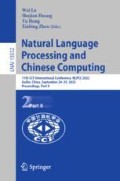Abstract
The topic information of the dialogue text is important for the model to understand the intentions of the dialogue participants and to abstractly summarize the content of the dialogue. The dialogue topic extraction task aims to extract the evolving topic information in long dialogue texts. In this work, we focus on topic extraction of dialogue texts in customer service scenarios. Based on the rich sequence features in the topic tags, we define this task as a sequence labeling task with sentences as the basic elements. For this task, we build a dialogue topic extraction system using a Chinese pre-trained language model and a CRF model. In addition, we use sliding windows to avoid excessive loss of contextual information, and use adversarial training and model integration to improve the performance and robustness of our model. Our system ranks first on the track 1 of the NLPCC-2022 shared task on Dialogue Text Analysis, Topic Extraction and Dialogue Summary.
Access this chapter
Tax calculation will be finalised at checkout
Purchases are for personal use only
References
Trivedi, A., Pant, N., Shah, P., Sonik, S., Agrawal, S.: Speech to text and text to speech recognition systems-a review. IOSR J. Comput. Eng 20(2), 3643 (2018)
Wang, L., Yao, J., Tao, Y., Zhong, L., Liu, W., Du, Q.: A reinforced topic-aware convolutional sequence-to-sequence model for abstractive text summarization. arXiv preprint arXiv:1805.03616 (2018)
Narayan, S., Cohen, S.B., Lapata, M.: Don’t give me the details, just the summary! Topic-aware convolutional neural networks for extreme summarization. arXiv preprint arXiv:1808.08745 (2018)
Wang, J., et al.: Sentiment classification in customer service dialogue with topic-aware multi-task learning. In: Proceedings of the AAAI Conference on Artificial Intelligence, vol. 34, pp. 9177–9184 (2020)
Xu, B., Wang, Q., Lyu, Y., Zhu, Y., Mao, Z.: Entity structure within and through- out: modeling mention dependencies for document-level relation extraction (2021)
Miyato, T., Dai, A.M., Goodfellow, I.: Adversarial training methods for semi-supervised text classification. arXiv preprint arXiv:1605.07725 (2016)
Jung, Y.: Multiple predicting K-fold cross-validation for model selection. J. Nonparametr. Stat. 30(1), 197215 (2018)
Luo, L., Lai, P.T., Wei, C.H., Lu, Z.: Extracting drug-protein interaction using an ensemble of biomedical pre-trained language models through sequence labeling and text classification techniques. In: Proceedings of the BioCreative VII Challenge Evaluation Workshop, pp. 26–30 (2021)
Liu, J., et al.: Topic- aware contrastive learning for abstractive dialogue summarization. arXiv preprint arXiv:2109.04994 (2021)
Xu, Y., Zhao, H., Zhang, Z.: Topicaware multi-turn dialogue modeling. In: The Thirty-Fifth AAAI Conference on Artificial Intelligence (AAAI-21) (2021)
Zou, Y., et al.: Topic-oriented spoken dialogue summarization for customer service with saliency-aware topic modeling. In: Proceedings of the AAAI Conference on Artificial Intelligence, vol. 35, pp. 14665–14673 (2021)
Huang, Z., Xu, W., Yu, K.: Bidirectional LSTM-CRF models for sequence tagging. arXiv preprint arXiv:1508.01991 (2015)
Kumawat, D., Jain, V.: POS tagging approaches: a comparison. Int. J. Comput. Appl. 118(6), 32–38 (2015)
Lample, G., Ballesteros, M., Subramanian, S., Kawakami, K., Dyer, C.: Neural architectures for named entity recognition. arXiv preprint arXiv:1603.01360 (2016)
Liu, B., Lane, I.: Attention-based recurrent neural network models for joint intent detection and slot filling. arXiv preprint arXiv:1609.01454 (2016)
JingHui, X., BingQuan, L., XiaoLong, W.: Principles of non-stationary hidden markov model and its applications to sequence labeling task. In: Dale, R., Wong, K.-F., Su, J., Kwong, O.Y. (eds.) IJCNLP 2005. LNCS (LNAI), vol. 3651, pp. 827–837. Springer, Heidelberg (2005). https://doi.org/10.1007/11562214_72
Liu, Z., Zhu, C., Zhao, T.: Chinese named entity recognition with a sequence labeling approach: based on characters, or based on words? In: Huang, D.-S., Zhang, X., Reyes García, C.A., Zhang, L. (eds.) ICIC 2010. LNCS (LNAI), vol. 6216, pp. 634–640. Springer, Heidelberg (2010). https://doi.org/10.1007/978-3-642-14932-0_78
Nguyen, N., Guo, Y.: Comparisons of sequence labeling algorithms and extensions. In: Proceedings of the 24th International Conference on Machine Learning, pp. 681–688 (2007)
Ma, X., Hovy, E.: End-to-end sequence labeling via bi-directional LSTM-CNNS-CRF. arXiv preprint arXiv:1603.01354 (2016)
Souza, F., Nogueira, R., Lotufo, R.: Portuguese named entity recognition using BERT-CRF. arXiv preprint arXiv:1909.10649 (2019)
Devlin, J., Chang, M.W., Lee, K., Toutanova, K.: BERT: pre-training of deep bidirectional transformers for language understanding. arXiv preprint arXiv:1810.04805 (2018)
Cui, Y., Che, W., Liu, T., Qin, B., Yang, Z.: Pre-training with whole word masking for Chinese BERT. IEEE/ACM Trans. Audio Speech Lang. Process. 29, 35043514 (2021)
Cui, Y., Che, W., Liu, T., Qin, B., Wang, S., Hu, G.: Revisiting pre-trained models for Chinese natural language processing. arXiv preprint arXiv:2004.13922 (2020)
Cui, Y., Yang, Z., Liu, T.: PERT: pre-training BERT with permuted language model. arXiv preprint arXiv:2203.06906 (2022)
Liu, Y., et al.: RoBERTa: a robustly optimized BERT pretraining approach. arXiv preprint arXiv:1907.11692 (2019)
Acknowledgements
This work is supported by grants from the Fundamental Research Funds for the Central Universities (No. DUT22ZD205).
Author information
Authors and Affiliations
Corresponding author
Editor information
Editors and Affiliations
Rights and permissions
Copyright information
© 2022 Springer Nature Switzerland AG
About this paper
Cite this paper
Pan, D., Yang, Z., Tan, H., Wu, J., Lin, H. (2022). Dialogue Topic Extraction as Sentence Sequence Labeling. In: Lu, W., Huang, S., Hong, Y., Zhou, X. (eds) Natural Language Processing and Chinese Computing. NLPCC 2022. Lecture Notes in Computer Science(), vol 13552. Springer, Cham. https://doi.org/10.1007/978-3-031-17189-5_21
Download citation
DOI: https://doi.org/10.1007/978-3-031-17189-5_21
Published:
Publisher Name: Springer, Cham
Print ISBN: 978-3-031-17188-8
Online ISBN: 978-3-031-17189-5
eBook Packages: Computer ScienceComputer Science (R0)


